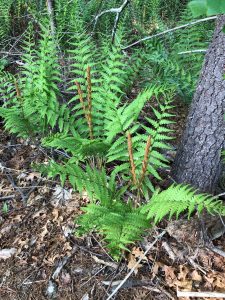
Summer is here, and most forest wildflowers have bloomed and set seed. If you enjoy identifying plants on your walks, may I suggest ferns? These are a fairly easy group of non-flowering plants to learn, as there are only 100 or so fern species in the northeastern area of the U.S. In most of our wooded areas, one can find up to twenty species in a morning; some ferns are even evergreen, and can be identified in the winter. On my walks in Westford, I have identified twelve of the common species: cinnamon fern, interrupted fern, Christmas fern, sensitive fern, polypody, Massachusetts fern, New York fern, marsh fern, lady fern, hayscented fern, bracken fern, and royal fern. I’m working on finding more in Westford. To id. these ferns, I use the excellent Peterson Field Guide to Ferns, written by Boughton Cobb, and also the iNaturalist app on my phone.
An intriguing element in the study of ferns is their lifecycle. Their reproduction does not follow the pattern of the flowering plants. In some ways it is more akin to animal reproduction. Ferns produce spores, either on a separate spike or frond, as does the cinnamon fern, or more commonly, as sori or clumps of spores, clustered together on the underside of fertile leaves or fronds. Each species has its own pattern and shape of sori, and this is a convenient way to identify the fern species.
Spores are usually tiny, almost microscopic bits of dust, released into the air on a dry day, to fly away from the parent plant. They remain viable for many years throughout climactic variations. The spore, landing on a suitable moist spot, develops into a very small single-celled prothallus. The prothallus adds cells over the next few weeks, and grows into a 1/4 inch thick gametophyte, which nourishes the whole process. This gametophyte develops a male end and a female end. The female organ produces several eggs, and exudes a chemical to attract sperm. The male organ produces and then releases sperm. The sperm require moisture in the ground so that they can swim to the female gametophytes in the area and fertilize their eggs. The first egg on the gametophyte to be fertilized, is the one that will develop into the plant, complete with roots and the first tiny leaf. The whole process of development to tiny plant may take three or four months. In taking a fern class at Garden in the Woods, I watched a video of this process, which is eerily like watching a video in sex ed. class. One gets the distinct feeling that we are closely related to these plants!
When walking this summer in moist areas, see how many different fern species you can find.
Many thanks to all flora and fauna reporters for the month of June. Please send reports by July 30, to appear in next month’s column. You can write to me at 7A Old Colony Drive, call me at 692-3907, or e-mail me at mariancharman@gmail.com.
————————-
May Report:
Rosemarie Koester, Providence Rd. May 6, Baltimore oriole…”How exciting, my first ever at our feeder”.
June Reports:
Rosemarie Koester, Providence Rd. June 4, male rose-breasted grosbeak visits frequently. Sometimes he is bullied by a cardinal. Catbird, chickadees, nuthatch, tufted titmouse, several doves, house finch, goldfinch, purple finch, two pairs of cardinals, blue jays, sparrows, one cowbird, hawk flying overhead, robins in yard, downy and red-bellied woodpeckers, ducks, several turkeys visiting each day, chipmunks, gray squirrels. Flora: many lady slippers around town, skunk cabbage, quite large now, poison ivy, milkweed plants in garden, invasive garlic mustard–pulled it all.
Marian/Bill Harman, Old Colony Drive. June 1, oriole heard in yard. June 4, walk on Tom Paul Trail: sedges, wild geranium, bouncing bet, honeysuckle, Baltimore oriole, pee-wee, cardinal, house finch, chickadees, jays. June 8, sweet juvenile male deer in the yard nibbling leaves–tiny new antlers coming in. June 11, phoebe heard in yard. Wood thrush heard in evening. June 17, wood thrush singing in morning, baby hairy woodpecker (small patch of red on top of head), begging from Mom at the feeder, then begging from the grackles, who ignored him. He landed on the feeder pole and kept sliding down–so much to learn! June 18, scarlet tanager heard. June 19, Juneteenth–a federal holiday for the first time. Three red-tailed hawks circling and crying out to each other. It looked like two adults and one juvenile. The juvenile was not a strong flyer yet–maybe its maiden flight. Wood thrush heard again here–its definitely in residence–very exciting. June 20, at Frances Hill Wildlife Sanctuary, ovenbird heard, palm warbler, great-crested flycatcher, chickadee, titmouse, phoebe. June 21, grackles, swamp sparrow heard, wood thrush, gold finches, robins, chickadee, titmouse, cardinal pair. June 25, Brown creeper, scarlet tanager singing repeatedly, chipping sparrow, pine warbler, titmouse, wood thrush singing, red-eyed vireo.
Bob Jefferies, Boston Rd. June 11, Baltimore oriole in yard–a first.
Marilyn Day, Graniteville Rd. June 25, Phil had a cicada killer in his shop (2″ long wasp-like insect, harmless to people).
____________
Marian Harman is a member of the Westford Conservation Trust, a non-profit conservation organization, whose purpose is the preservation of Westford’s open spaces and trails. The Trust welcomes new members and volunteers. Check out our website at westfordconservationtrust.org, or visit us on Facebook.
